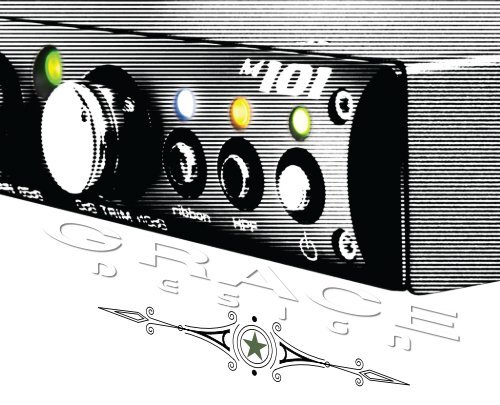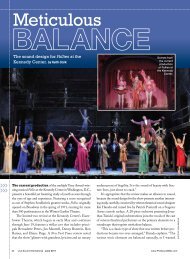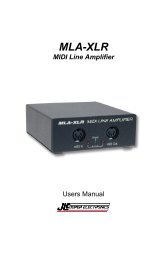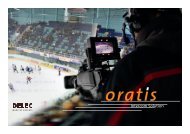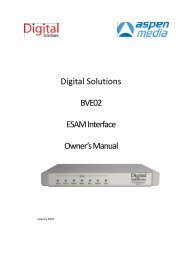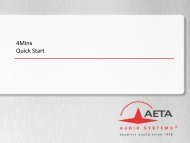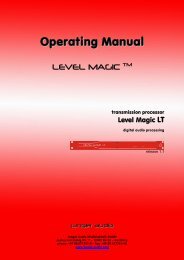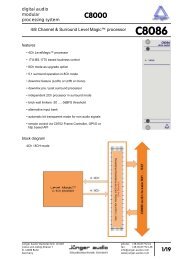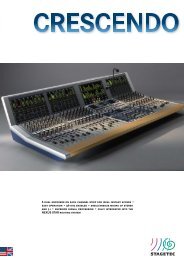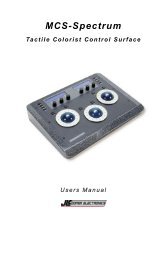Grace Design Catalogue - PDF - Aspen Media.
Grace Design Catalogue - PDF - Aspen Media.
Grace Design Catalogue - PDF - Aspen Media.
You also want an ePaper? Increase the reach of your titles
YUMPU automatically turns print PDFs into web optimized ePapers that Google loves.
Love my grace 101 which ive had for 2 years. I also have a new ribbon microphone, when I saw the new m101 advertised, I jumped for joy. I bought it and was not<br />
disappointed! After reading pages of reviews and searching the web for comments for a couple months before buying the grace 101, I can honestly testify that everything<br />
I ever read about the dead on sonic qualities of this pre amp is absolutely true. Im in for another for my live vocal rig! Beautiful design, intuitive to use, killer<br />
sound! I am a bass player and I am using the 101 for live and recording. I would say I love it its great.....Great tone thanks so much. I am using your m904b controller<br />
with *** mains, *** sub and *** cable.The sound of this controller is very well rounded, with outstanding accuracy and detail, leting you hear very, very subtle<br />
detail and air around the low and high freqs, with no hype at all in the top end. The mids are rock solid. The lows are phase accurate, tight and very well controled.<br />
The headphone amp is stellar useing my *** ***s, the x-feed circuitry is awsome! All of this comes from a/b test with our *** and *** units in our other room. I bought<br />
a 101 preamp after auditioning a unit against several competitors. I liked it so much I decided to buy two. Great piece, great price. Neal has been a great help<br />
assisting me with selecting the right grace product for my situation. Please pass along my thanks to him. The 201 faithfully reproduces the dynamics of a string<br />
quartet, piano and solo violin like no other product I have tried. Also, they make modest price microphones ($250-400) sound wonderful and expensive mics ($750-1000)<br />
sound pristine. Am hopeful grace will come out with a stand alone 8 channel a/d-d/a box similar to whats optional in the 801 in the future. Sooner or later, I will<br />
make the move to digital (getting a bit tired of lugging my multitrack reel to reel around to live performances) and dont want to compromise the 201 output at all.<br />
The m906 is fablulous! Great sound, great stability and powerful combinations. Now I can record, mix and master my works with accurate and precise monitoring for<br />
virtual everything I need. It\s the center of my entire digital/analog studio. Thank you grace design. This unit sounds fantastic, has great features and its great<br />
looks certainly dont hurt. I bought this one for home reference listening of my work. I plan on buying two more for the mastering studio in the near future. The name<br />
headphone amp is misleading. True, the unit is a great headphone amp but can also be an outboard dac, or a fine preamp since analog inputs are available. The separate,<br />
remote controlled, level controls with .05 Db matching for a 99 db range is unmatched by any (affordable) passive potentiometer. It also looks like a professional<br />
piece of equipment. I am so impressed with grace design as a whole. The website is fantastic. I was able to study the m902\s manual before I received the actual unit,<br />
which allowed me to get my questions answered before I was tasked with installing the m902 into my reference system. What an absolute pleasure it was to talk with<br />
neal thompson about my particular questions concerning unity gain settings and other line output connection issues. Pleasant and deeply knowledgable, he clearly<br />
answered all my questions and gave me valuable insight with some recommendations for product usage and feature descriptions. From the packaging to the actual unit<br />
itself, everything just exudes quality. The annunciation and tactile feel of the m902 outperforms even my *** (though I love my *** even though I am a corporate<br />
pilot by profession, I wa!S educated as a mechanical engineer. I routinely operate! Aircraf t which cost in excess of 40 million dollars, so I feel I am qualified to<br />
say that I truly can appreciate the high level of engineering that went into the design and production of the m902 reference headphone amplifier. I will close with<br />
what every good audio reviewer has said so far about the m902, my highest recommendation. Bravo. Beautiful unit. Well thought out. I purchased this unit over the ***<br />
because of the feature set, asthetics, and amount of digital i/o and digital routing. Sonic quality: transparent, clean, silent!!! Stereo image jumps from the speakers.<br />
This unit is a great match for my needs & workflow. A great-sounding, transparent, beautifully-built & robust surround controller! The 101 made me very angry<br />
- it kept showing all the flaws in my mics and my room! But I figured I could trust someone who doesnt lie to me rather than someone who tells me what I want to hear.<br />
Great pre! I opened the box and immediately put it into action on a session. I was speechless! Thank you. Looking forward to putting the m201 through its paces. Looks<br />
great in the rack! I researched preamps for a very long time prior to making the choice of the grace design model 101. Once I plugged in my km184 and strummed my<br />
acoustic, I fell in love. I didn\t know a mic\d instrument could actually sound as good as a purely acoustic experience. All I can say is the grace 201 preamp is the<br />
best sounding pre i\ve ever owned and used! The reviews don\t lie or exaggerate. I\ll keep this one for a life-time. My recordings have never sounded so pristine and<br />
full of depth and character. Thank you grace design!!!! The sonic clarity of the m901 is amazing. I can hear details in my sounds that I never heard before, especially<br />
with my new *** headphones. I do 95% of my sound design on headphones now and only use the genelecs when doing lcrs or 5.1 Work. It was everything I had hoped<br />
for! I do a significant quantity of organ, choral, orchestral and chamber recordings. As good as the monitoring is on my ***, this is better. Coupled with my *** I<br />
have an unbeatable combination and produce astonishing results with the entire chain. The m902 deserves highest merit in quality of construction, attention to detail,<br />
innovation and functionality. As a headphone amplifier, it has no peer in it\s price range and sonic attributes. As a preamplifier, it peforms as well as units costing<br />
much more. The fact that it does so many things in it\s compact dimensions transcends further comment as the proof is in the listening. <strong>Grace</strong> designs makes a<br />
bold statement with this product and sets a fine example for other manufacturers to aspire towards. Congratulations on a product of particular distinction. Im setting<br />
up an editing suite, and i\d love to place posters of products I use and reccommend for clients to see. If you could provide any promotional materials that I could<br />
display (posters, etc.) I would be much obliged, as I am very pleased with my lunatec v3. This mic pre brings together great sound and easy of use. In my book, thats<br />
a killer combination! In my work, it is imperative that I be able to move fast and rely on my gear. Thanks!! <strong>Grace</strong> design products are transparent. I can completely<br />
trust that my grace handles audio signals with least impact on the sound I put in. That transparency actually puts me in better control of the ultimate sound I am<br />
trying to achieve. Thank you! The rather unique combination of analog/digital and usb at this audiophile level in a compact bullet proof housing, not unlike my<br />
powerbook 17\s aircraft grade aluminum, make this product the choice. M902 is a such a versatile little wonder, driving *** or *** , or driving our power amps ***<br />
and studio monitors *** directly, this audiophile and versatile powerbrick always performs with finesse and detail, power and insight. Model 801r- we own a second<br />
801r - so the new registration address applies to this unit also. We did a ad converter test, including a da/ad loop of an original soundfile. The new files were<br />
rerecorded through a *** into all 5 ad converters, and also 5 times with a gracedesign 801r inserted. While some converters had only neglegible differences, none of<br />
them were able to show any difference between no 801r and an 801r inserted ! This must mean either no converter was transparant enough, or the 801r is transparant<br />
enough. While we did this test to check for differences in absolute transparancy of the ads, it turned out to be another proof that we shouldn\t bother to invest<br />
in another brand of mic pre. So we happily expanded our 801r with a second one and a 801rcu. What a fabulous product! The build quality and performance are<br />
top notch. I would recommend it for anyone as the first line preamp for clean, honest gain. M906 - m906... What a sound... What a design... What a<br />
class... Entirly on it\s own... Lonely at the top :-) congratulations! Please continue the good work :-) I really enjoy the features added since<br />
the 901: line out, volume readout, switching between line out & phones, usb addition for listening to itunes, x-feed all of which are<br />
seamless with the remote. And of course the m902 is a beauty to look at. The 101 is by far the cleanest channel you can buy for<br />
under $1000. You won\t find a more musical, more sonically pristine preamp anywhere else for this price. After using onboard<br />
pre\s on a behringer board for years and accepting the sound for\what it was\, recording with the 101 is sonically<br />
like putting on a pair of prescription glasses for the first time. You make an excellent product at a reasonable<br />
price. Its electronic performance, build quality and semi-industrial look appeal to me. Your customer<br />
service is responsive and effective, qualities that go a long way in customer satisfaction. The<br />
801 is a beautiful piece of hardware! Easy to use, amazing sound, impossible to beat! Top<br />
quality, great sound and unbelievably feature rich for the small size...Good job.<br />
Exceeding my expectations! Great work! A new reference in 2 channel portables<br />
you guys rock! Great products!! Great product!!!!! I am in love with<br />
this!Yall rule! I love this v3. Absolutely amazing! I havent made<br />
a bad tape yet! Elegant sonic perfection! Excellent unit!!!<br />
Great performnce. Very flat response. No coloring.<br />
Awesome units - 1st class design! Great<br />
product, thanks! Great product! Like<br />
At <strong>Grace</strong> <strong>Design</strong> our dedication to creating exceptional audio equipment is driven by<br />
our love of music and the art of recording it.<br />
As our industry evolves to suit the whims of an ever expanding and diluted<br />
marketplace, our mission comes ever more into focus: to build beautiful products<br />
of tangible and lasting value which will help engineers, musicians and audiophiles<br />
become more engaged with the creation and presentation of great music.<br />
The products featured in this catalog are the result of the ongoing dialog<br />
between ourselves and our esteemed peers in the professional audio<br />
industry. It is with great honor and respect that we offer these<br />
products to the world, and with high hopes that they will continue<br />
to facilitate the pursuit of great art.<br />
the mechanical design and itsounds<br />
great! Cool<br />
product. Thanks!<br />
I have
m906 5.1 and stereo monitor controller<br />
high fidelity 5.1 and stereo monitor control for recording, mastering, film, broadcast and post.<br />
The landscape of pro audio has<br />
changed. Computer based audio production<br />
has greatly reduced the need for large<br />
format recording consoles, minus one part:<br />
the master section. This progression has<br />
created a need for a whole new genre of<br />
products - the monitor controller, of which<br />
there are many offerings, from simple to full<br />
featured. <strong>Grace</strong> <strong>Design</strong> proudly offers the<br />
pinnacle: the m906 high fidelity 5.1 monitor<br />
controller.<br />
The main idea behind the m906 was to<br />
provide high fidelity level control for engineers<br />
working with 5.1 surround playback<br />
systems. But from there, we got blissfully<br />
carried away and ultimately obsessed with<br />
producing the most full featured and highest<br />
quality monitor controller available.<br />
At its core, the m906 is a purist level<br />
control for monitoring surround (or stereo)<br />
audio sources. But a closer look reveals a<br />
highly intelligent feature set that makes it a<br />
vital nerve center for any recording, mastering,<br />
or post facility centered around a digital<br />
audio workstation. It is configured as a 2U<br />
rack mount mainframe controlled by a sleek,<br />
powerful desktop remote control, with all<br />
audio kept in the mainframe and all control<br />
via the remote control.<br />
The m906 offers a full complement<br />
of balanced and unbalanced analog 5.1<br />
and digital 5.1 and stereo inputs, the latter<br />
featuring our latest generation reference<br />
24bit/192kHz DAC technology with our<br />
proprietary s-Lock PLL for rock solid digital<br />
stability (more info can be found in the technical<br />
discussion). All inputs and outputs on<br />
the m906 can be user calibrated for seamless<br />
integration into any playback environment<br />
with all types of playback equipment.<br />
The m906’s signal path is designed to<br />
deliver nothing short of the best performing,<br />
transparent audio available. All components<br />
are chosen for audiophile performance and<br />
long term reliability. Level controls, the heart<br />
of a monitor controller, are low distortion<br />
precision devices which provide a 100dB<br />
range in silent .5dB steps.<br />
Included as a standard feature is our<br />
acclaimed reference headphone amplifier<br />
circuitry (from our m902), with one output<br />
jack on the mainframe and one additional<br />
output on the remote. This unique circuitry<br />
provides precision headphone amplification<br />
for critical monitoring, mixing and<br />
mastering.<br />
While the m906 boasts a remarkably full<br />
set of features, the real achievement for us<br />
is to offer this while maintaining the impeccable,<br />
transparent audio performance for<br />
which all of our products are famous. In its<br />
few short years in production, the m906 has<br />
found a home in countless of the world’s<br />
premier audio production, HD production,<br />
broadcast, post and mastering facilities.<br />
The m906 is here to empower audio<br />
professionals with the highest performance<br />
and most comprehensive feature set that<br />
any surround monitor control system has to<br />
offer.
• multiple 5.1 and stereo analog inputs<br />
• 24bit/192kHz digital 5.1 and stereo inputs- AES3,<br />
S/PDIF, ADAT and TOSLINK<br />
• s-Lock phase lock loop sample clock regeneration<br />
for ultra-low jitter and rock solid digital<br />
stability<br />
• precision speaker and headphone level controls<br />
with a 100dB range in 0.5dB steps<br />
• every electrical and mechanical design element<br />
maximized for absolute purist audiophile performance<br />
• all controls are built into an elegant, convenient<br />
desktop remote control unit<br />
• all I/O and audio are routed in a 2U rack mount<br />
mainframe powered by an external 1U 1/2 rack<br />
power supply<br />
• control up to three speaker systems - two 5.1 or<br />
up to three stereo<br />
• m902 style high-current audiophile headphone<br />
amplifier built in with one output on remote<br />
control unit and one on the mainframe unit<br />
• complete system level calibration (inputs, outputs,<br />
inter-channel balance, dim) and individual<br />
channel solo/mute<br />
• balanced talkback microphone input and activation<br />
switch with additional external foot switch<br />
control jack<br />
• fixed level 5.1 DAC output for direct audio transfers<br />
• optional downmix module supports all standard<br />
Dolby mix ratios<br />
• optional AES Loop-thru feature provides four<br />
AES digital outputs for passing signals to other<br />
devices downstream<br />
SPECIFICATIONS ANALOG IN<br />
THD+N (@ 0dB gain, 1kHz)<br />
@+20dBu out<br />
@ 0dBu out<br />
Frequency Response<br />
+/-3dB<br />
Dynamic Range<br />
20-22kHz bandwidth<br />
Output Noise (20-22kHz bandwidth, -20dB gain)<br />
High gain mode<br />
Low gain mode<br />
Output Noise (A weighted, -20dB gain)<br />
High gain mode<br />
75dB<br />
>60dB<br />
-105.5dB to +20dB<br />
-95.5dB to +30dB<br />
+/-0.05dB<br />
+15dBu<br />
+27dBu<br />
+30dBu<br />
+20dBu<br />
30k Ohms<br />
50k Ohms<br />
300 Ohms<br />
300 Ohms<br />
D/A CONVERTER FIXED OUTPUTS<br />
THD+N<br />
1kHz, -1dBFS, 20-22kHz bandwidth 0.002%<br />
Dynamic Range<br />
20-22kHz bandwidth<br />
AES3 / S/PDIF<br />
TOSLINK<br />
ADAT LIGHTPIPE<br />
s-Lock Sample Clock Intrinsic Jitter<br />
s-Lock Supported Sample Rates<br />
POWER SUPPLY / GENERAL<br />
Power consumption<br />
Input Voltage 50-60Hz<br />
Main chassis IEC 2U<br />
Remote control unit<br />
Power supply unit<br />
Main chassis<br />
Remote control unit<br />
Power supply unit<br />
Input Lock Range<br />
Dimensions<br />
Weight<br />
>111dB<br />
32kHz to 192kHz<br />
32kHz to 96kHz<br />
30kHz 55kHz<br />
high fidelity stereo monitor control for recording, mastering, film, broadcast and post.<br />
m904 stereo monitor controller<br />
While 5.1 surround has become<br />
well established in film and HD production,<br />
stereo is still king and remains the standard<br />
for producing and delivering music. Accordingly,<br />
we offer our monitor controller<br />
in a stereo only version - the m904.<br />
The m904 combines all the same<br />
features and technology found in our<br />
flagship m906 surround controller, and is<br />
the perfect nerve center for any type of<br />
audio production facility - from project<br />
studio to world class mastering facility.<br />
The m904 offers a full complement of<br />
balanced and unbalanced stereo analog<br />
and digital inputs, the latter featuring our<br />
latest generation reference 24bit/192kHz<br />
DAC technology with our proprietary<br />
s-Lock PLL for rock solid digital stability<br />
(more info can be found in the technical<br />
discussion). All inputs and outputs are easily<br />
user calibrated for seamless integration into<br />
any playback environment with all types of<br />
playback equipment.<br />
The m904 is configured as a 2U rack<br />
chassis, with all system controls built<br />
into the front panel, or is available as the<br />
m904b, with a blank 2U mainframe which is<br />
controlled by a separate remote control unit<br />
(m904RCU sold separately). Additionally,<br />
a standard m904 can be used with the<br />
m904RCU, so the user can select between<br />
local and remote control.<br />
Included as a standard feature is our<br />
critically acclaimed reference headphone<br />
amplifier circuitry (as featured in our m902),<br />
with two output jacks on the mainframe<br />
or one jack on the m904b and one on<br />
the m904RCU. This circuitry provides<br />
absolutely pristine audiophile headphone<br />
amplification for critical monitoring, mixing<br />
and mastering.<br />
While the m904 provides an unparalleled<br />
list of useful features, the real achievement<br />
for us was to implement all of this<br />
while maintaining our trademark musical,<br />
high fidelity audio performance. All components<br />
are selected and design decisions<br />
made for absolute audio transparency and<br />
long term reliability, making this the perfect<br />
link between your mix and monitors.<br />
The m904 is here to empower audio<br />
professionals with the highest performance<br />
and most comprehensive feature set that<br />
any stereo monitor control system has to<br />
offer.<br />
optional m904 remote control unit
• multiple stereo analog inputs<br />
• 24bit/192kHz digital stereo inputs- AES3, S/PDIF,<br />
ADAT and TOSLINK<br />
• s-Lock phase lock loop sample clock regeneration<br />
for ultra-low jitter and rock solid digital<br />
stability<br />
• precision speaker and headphone level controls<br />
with a 100dB range in 0.5dB steps<br />
• every electrical and mechanical design element<br />
maximized for absolute purist, audiophile performance<br />
• available as the m904b, with a blank panel mainframe<br />
unit and controlled via m904RCU (sold<br />
separately)<br />
• all I/O and audio are routed in the 2U rack mount<br />
mainframe powered by an internal AC supply<br />
• multiple speaker set selection - up to 3 stereo<br />
sets<br />
• m902 style high-current audiophile headphone<br />
amplifier built in with two outputs on front<br />
panel<br />
• complete system level calibration (inputs, outputs,<br />
inter-channel balance, dim)<br />
• balanced talkback microphone input and activation<br />
switch with additional external foot switch<br />
control jack<br />
SPECIFICATIONS ANALOG IN<br />
THD+N (@ 0dB gain, 1kHz)<br />
@+20dBu out<br />
@ 0dBu out<br />
Frequency Response<br />
+/-3dB<br />
Dynamic Range<br />
20-22kHz bandwidth<br />
Output Noise (20-22kHz bandwidth, -20dB gain)<br />
High gain mode<br />
Low gain mode<br />
Output Noise (A weighted, -20dB gain)<br />
High gain mode<br />
65dB<br />
>60dB<br />
-105.5dB to +20dB<br />
-95.5dB to +30dB<br />
+/-0.05dB<br />
+15dBu<br />
+27dBu<br />
+30dBu<br />
+20dBu<br />
30k Ohms<br />
50k Ohms<br />
300 Ohms<br />
300 Ohms<br />
D/A CONVERTER FIXED OUTPUTS<br />
THD+N<br />
1kHz, -1dBFS, 20-22kHz bandwidth 0.002%<br />
Dynamic Range<br />
20-22kHz bandwidth<br />
AES3 / S/PDIF<br />
TOSLINK<br />
ADAT LIGHTPIPE<br />
s-Lock Sample Clock Intrinsic Jitter<br />
s-Lock Supported Sample Rates<br />
POWER SUPPLY / GENERAL<br />
Power consumption<br />
Input Voltage 50-60Hz<br />
Main chassis IEC 2U<br />
Remote control unit<br />
Main chassis<br />
Remote control unit<br />
Input Lock Range<br />
Dimensions<br />
Weight<br />
>111dB<br />
32kHz to 192kHz<br />
32kHz to 96kHz<br />
30kHz 55kHz<br />
headphone amplifier, DAC and monitor control for professional and audiophile applications<br />
m902 reference headphone amplifier, DAC, monitor controller<br />
Presenting the audio microscope.<br />
Simply plug in your favorite headphones,<br />
cue up your favorite reference material and<br />
get ready to hear, literally, what you’ve been<br />
missing, courtesy of the m902 reference<br />
headphone amplifier.<br />
At the core of the m902 is our audiophile,<br />
high-current transimpedance amplifier<br />
circuitry, which effortlessly drives even<br />
the lowest impedance headphones and<br />
provides the high-resolution and low-level<br />
ambient detail for which all <strong>Grace</strong> <strong>Design</strong><br />
products are famous. This circuitry makes<br />
familiar recorded material become at once<br />
transparent and alive, while critical details<br />
in editing and mastering become obvious<br />
and easy to manipulate.<br />
Professionals and audiophiles alike<br />
are continually floored by the m902’s high<br />
performance 24bit/192kHz DAC, which<br />
includes our unique s-Lock dual stage PLL<br />
(Phase Lock Loop) for extremely low intrinsic<br />
jitter and rock solid digital performance.<br />
A full complement of analog and digital<br />
inputs are provided (AES3, S/PDIF, TOSLINK<br />
and USB), which are selectable via a front<br />
panel rotary switch. We offer an optional<br />
infrared remote control, which provides the<br />
essential controls for anyone working out<br />
of reach of their m902.<br />
The m902 cleverly adds stereo unbalanced<br />
or optional balanced (m902b) analog<br />
line outputs for connection to powered<br />
studio monitors or amplifiers. This allows<br />
it to double as an elegantly simple high<br />
fidelity monitor controller or even a purist<br />
audiophile preamplifier / DAC. And, similar<br />
to its big brothers (m906, m904), the m902<br />
provides some essential user calibration<br />
settings which help it to integrate into any<br />
playback environment.<br />
The m902 includes a crossfeed circuit,<br />
or XFeed, which simulates the natural<br />
acoustics of a loudspeaker listening environment<br />
and HRTF (Head Related Transfer<br />
Functions). This circuitry, designed by Dr.<br />
Jan Meier, can significantly improve imaging,<br />
while reducing listening fatigue when<br />
using headphones.<br />
Celebrated by audiophiles and audio<br />
engineers alike, the m902 is our crossover<br />
smash hit and is a must have for anyone<br />
searching to discover new depths in music<br />
and sound.<br />
optional infrared remote
• balanced and unbalanced analog inputs<br />
• 24bit/192kHz digital stereo inputs- AES3, S/<br />
PDIF, TOSLINK and USB (USB input supports<br />
16 bit/44.1 and 48k only)<br />
• s-Lock phase lock loop sample clock regeneration<br />
for ultra-low jitter and rock solid<br />
digital stability<br />
• high-current transimpedance headphone<br />
amplifier circuitry built to effortlessly drive<br />
low impedance headphones<br />
• unbalanced variable level analog line outputs<br />
for studio monitors, optional balanced outputs<br />
(m902b)<br />
• all electrical and mechanical design elements<br />
maximized for absolute purist, audiophile<br />
performance<br />
• precision level control with a 99.5dB range in<br />
0.5 dB steps<br />
• channel level matching accuracy of 0.05dB<br />
• crossfeed circuitry (XFeed) for improved<br />
headphone imaging<br />
• optional infrared remote control available<br />
• internal linear power supply with custom<br />
wound toroidal transformer<br />
• no electrolytic capacitors in the signal path<br />
SPECIFICATIONS ANALOG IN<br />
Gain<br />
Normal Mode<br />
Boost Mode<br />
@ 0dBu out +/- .25dB<br />
@ 0dBu out +/- .5dB<br />
@ 0dBu out +/-3dB<br />
@1kHz, 50 Ohm load<br />
INPUT<br />
INPUT<br />
OUTPUT<br />
@ 0dB gain<br />
@ -10dB gain<br />
Frequency Response<br />
Maximum Output Level<br />
Impedance<br />
Dynamic Range<br />
THD+N<br />
+0dB<br />
+10dB<br />
22Hz - 120kHz<br />
12Hz - 260kHz<br />
4Hz - 600kHz<br />
+21.4dBu (9.11Vrms)<br />
106K Ohms balanced<br />
53K Ohms unbalanced<br />
+10dBu out, 50 Ohm load, SMPTE 4:1
TECHNICAL DISCUSSION<br />
THE<br />
Analog<br />
Amplifier Topology - <strong>Grace</strong> <strong>Design</strong><br />
microphone preamplifiers are fully balanced,<br />
with transformerless inputs and<br />
outputs. The input amplifiers are based<br />
on monolithic, low noise instrumentation<br />
amplifiers. Gain core sections are<br />
transimpedance, or “current feedback”<br />
amplifiers, which have many important<br />
advantages over traditional “voltage<br />
feedback” op-amps.<br />
First, transimpedance amplifiers<br />
have a nearly constant bandwidth over<br />
a wide gain range and are not prone to<br />
large-signal slew rate limiting, which<br />
results in improved dynamic performance.<br />
Compared to voltage feedback<br />
op-amps (which are found in most<br />
preamplifier designs), transimpedance<br />
amplifiers have better dynamic performance<br />
and are able to track complex<br />
harmonics without adding any metallic<br />
or “solid-state” character to the sound.<br />
Also, transimpedance amplifiers reveal<br />
greater detail and provide a more open,<br />
musical sound quality. Furthermore,<br />
transimpedance amplifiers maintain the<br />
same sound quality all the way up to the<br />
highest gain levels, which makes them<br />
dramatically superior for use with low<br />
output ribbon microphones.<br />
Output Driver Stages - The<br />
balanced output stage of our preamplifiers<br />
is capable of driving extremely long<br />
cable runs and load impedances down<br />
to 50 Ohms. Transient performance is<br />
superb and is not compromised when<br />
operating in unbalanced modes.<br />
Integrated Vs. Discrete - Our gain<br />
core integrates the balanced input amplifiers<br />
on a single die and we feel that the<br />
advantages of this over a traditional “discrete”<br />
layout approach are important to<br />
understand. With the integrated amplifier<br />
components in very close proximity<br />
to each other, the paths of critical signals<br />
are kept very short. As well, energy storage<br />
from stray circuit board capacitance<br />
and inductance is eliminated. Integration<br />
of the input amplifiers also provides superior<br />
thermal tracking of input transistors<br />
and feedback resistors. It’s true that<br />
in the early days of integrated circuits,<br />
it was better to design a discrete circuit<br />
because it was not yet possible to create<br />
transistors and resistors of the same<br />
quality as discrete devices. But today the<br />
quality of integrated transistors and resistors<br />
allows integrated circuits to achieve<br />
a much higher level of sonic purity than<br />
even the best discrete designs.<br />
Misconceptions about “Class A“<br />
operation - In the early days of solid<br />
state power amplifiers, class B push-pull<br />
output stages were prone to crossover<br />
distortion, which was particularly bad<br />
sounding. By changing the operation<br />
mode to class A, designers were able to<br />
eliminate this crossover distortion, but<br />
at the expense of dramatically higher<br />
power consumption and lower available<br />
power for the speaker. But subsequent<br />
advancements in output stage topology<br />
resulted in class AB mode, which dramatically<br />
reduced crossover distortion<br />
without the power requirements of class<br />
A operation.<br />
In regards to low level electronics,<br />
such as microphone preamplifiers, class<br />
A or AB is essentially irrelevant in determining<br />
over all sound quality, as these<br />
are not power amplifiers. Modern lowlevel<br />
high speed integrated amplifiers<br />
are free from the problems of primitive<br />
solid state power amplifiers because<br />
they do not employ large geometry<br />
power transistors, and are not required<br />
to drive low impedance loudspeakers.<br />
Other design elements such as capacitor<br />
type, resistor quality, power supply<br />
grounding and circuit board layout combine<br />
to have a much greater net effect<br />
on sound quality - much more so than<br />
whether or not a design operates in class<br />
A or class AB mode.<br />
Controls - Each gain control used<br />
in all our preamplifiers (with the exception<br />
of the m802 remote controlled preamplifier)<br />
consists of a precision switch<br />
wired with 1% metal film resistors. The<br />
advantages of a fixed resistor switch over<br />
a potentiometer for gain setting are substantial:<br />
as music signal flows through<br />
a potentiometer, the potentiometer’s<br />
temperature modulates, causing its<br />
resistance to modulate. As the value of<br />
resistance changes, so does the amplifier<br />
gain, resulting in unwanted dynamic distortion.<br />
Most conductive plastic potentiometers<br />
have temperature coefficients<br />
of +/-1000ppm/ºC, which can cause<br />
considerable signal degradation at high<br />
amplifier gains. By comparison, a metal<br />
film resistor has a typical temperature<br />
coefficient of +/-50ppm/ºC, which represents<br />
more than an order of magnitude<br />
improvement in thermal stability.<br />
Relays - To keep signal paths as<br />
short as possible, relays are used to perform<br />
phase reverse, input selection and<br />
input attenuator functions. Sealed, gold<br />
contact relays offer no signal degradation<br />
and are completely reliable (rated<br />
for over 50 million operations without<br />
significant change in contact resistance).<br />
Power Supply - The power supply<br />
is the heart of any audio device. All of our<br />
products (excluding the Lunatec V3 and<br />
m101) incorporate robust linear power<br />
supplies. The IEC AC power entry module<br />
includes a power line RFI filter and<br />
provides switching for 100/120/220/230-<br />
240VAC. High efficiency, low radiated<br />
noise toroidal transformers are used for<br />
power conversion. All of the audio DC<br />
power supplies have two stages of regulation-<br />
one in the power supply and one<br />
on each audio pcb, which ensures that<br />
there is no interaction between channels.<br />
Phantom power is provided with a<br />
two-stage low-noise +48V regulator.<br />
Grounding - Correct power supply<br />
and signal grounding is a prerequisite to<br />
high fidelity audio performance. Each<br />
of our audio circuit boards incorporates<br />
a low inductance copper ground plane<br />
which provides a very stable signal and<br />
power supply reference. For added<br />
noise immunity, the 5V logic/relay and<br />
LED power supplies have their own<br />
ground returns.<br />
Passive Components - Selection<br />
of passive components is as critical as<br />
any other aspect of audio design. The<br />
quality of resistors, capacitors, inductors,<br />
connectors, wire, switches and even<br />
solder have significant effects on sonic<br />
quality. All of the passive components<br />
in our designs are selected for optimum<br />
sonic performance and long term reliability.<br />
Capacitors have the most significant<br />
impact on signal purity. The only signal<br />
path capacitors used are for phantom<br />
power de-coupling, which are ultralinear<br />
metalized film capacitors. The rest<br />
of the audio circuit is direct-coupled with<br />
DC servo control. There are no electrolytic<br />
capacitors in the signal path, which<br />
have poor temperature stability, high<br />
dielectric absorption, wide tolerances<br />
and a relatively short life span. Dielectric<br />
absorption causes a capacitor to retain a<br />
certain quantity of its charge when discharged,<br />
which then leaks out over time,<br />
causing a smearing of high frequencies,<br />
which can result in the all too common<br />
harsh, “solid state” sound quality.<br />
By contrast, film capacitors have<br />
dramatically less dielectric absorption<br />
than even the best electrolytic capacitors,<br />
which results in much improved<br />
transient performance, enhanced spatial<br />
accuracy and low frequency realism.<br />
As well, film capacitors are available in<br />
much tighter tolerances which, in the<br />
case of balanced input de-coupling, is<br />
important for acceptable low frequency<br />
common mode rejection. The use of film<br />
capacitors instead of electrolytic types<br />
results in a much more natural, less “metallic”<br />
sonic character.<br />
All audio related resistors are precision<br />
metal film types for low noise and
superior temperature stability, and all<br />
critical signal path resistors are fabricated<br />
with copper end caps rather than<br />
steel, which helps to avoid any inductive<br />
reactance. Ferrite beads, common<br />
mode chokes, and highly stable polypropylene<br />
capacitors form an input<br />
filter to protect the input amplifiers<br />
from RF interference. Ferrite beads also<br />
protect the output amplifiers from any<br />
interference on the output wires.<br />
Digital<br />
Analog to Digital Converters -<br />
Our new A/D converters represent the<br />
state of the art in high performance<br />
conversion for the most demanding<br />
music recording applications. An A/D<br />
converter can be divided into three<br />
basic functional blocks; the analog<br />
input stage, the A/D converter, and<br />
the clock generation (or regeneration).<br />
With any high performance A/D converter<br />
design, all three of these areas<br />
require complete attention and must<br />
be perfectly realized to achieve true<br />
high fidelity audio performance.<br />
Analog Input Stage - Our<br />
converter’s analog input circuitry is<br />
designed to be simple and pure. This<br />
fully differential circuitry contains no<br />
electrolytic capacitors and utilizes precision<br />
0.5% tolerance thin film resistors,<br />
which guarantees no signal coloration<br />
from capacitor dielectric absorption<br />
and resistor thermal modulation. Careful<br />
attention to grounding and power<br />
supply layout guarantees no sonic aberrations<br />
caused from unwanted interference<br />
from digital circuitry. The analog<br />
input amplifiers are powered from<br />
their own dedicated voltage regulators<br />
and each analog power supply rail is<br />
double regulated to provide extreme<br />
isolation from power line related noise.<br />
Driving the input of modern deltasigma<br />
converters requires a low driving<br />
impedance and high current from the<br />
A/D input driver, and our experience<br />
from designing high performance microphone<br />
amplifiers with precision line<br />
drivers translates very well to this task.<br />
A/D Converter - The A/D converter<br />
itself is the Cirrus CS5381. This<br />
converter employs a fifth order deltasigma<br />
modulator and a low pass filter<br />
that exhibits very wide dynamic range<br />
and low latency. With a more gentle<br />
slope digital filter than other ADC chips,<br />
the CS5381 is the most musical of the<br />
high end converter ICs and is capable<br />
of 120dB dynamic range with distortion<br />
and noise artifacts at less than<br />
-110dB. Separate power supplies for<br />
the analog and digital portions of the<br />
A/D converter ensure that the precision<br />
delta sigma modulator will not be<br />
affected by other surrounding circuitry.<br />
As well, the differential inputs provide<br />
additional input noise rejection.<br />
Clocks - A perfectly executed analog<br />
stage and the best performing A/D<br />
converter is only as good as the sampling<br />
clock. Even the smallest amounts<br />
of clock jitter will readily degrade the<br />
performance of the converter by introducing<br />
non-harmonically related noise<br />
and distortion.<br />
When operating on the internal<br />
clock, the A/D converter sample clock<br />
is generated by a quartz oscillator<br />
which has very low jitter. However,<br />
many applications require that the A/D<br />
converter be synchronized to an external<br />
clock source, usually in the form of a<br />
word clock, which is where the greatest<br />
challenge arises.<br />
There is a common misconception<br />
that using the word clock input on any<br />
piece of digital audio equipment will<br />
result in better sonic performance. In<br />
reality, the vast majority of word clock<br />
PLL circuits will have more intrinsic<br />
jitter than the word clock signal itself<br />
and usually more intrinsic jitter than<br />
the PLL within the AES/SPDIF receiver<br />
chip. As well, these PLLs usually have<br />
no incoming jitter attenuation in the<br />
audio band.<br />
Our A/D converters employ<br />
s-Lock, a two stage PLL system to<br />
provide practically jitter-free recovered<br />
clocks with extremely high incoming<br />
jitter attenuation. The first stage is a<br />
wide lock range ultra low noise analog<br />
PLL, which can lock to incoming word<br />
clocks and Digidesign® Loop Sync<br />
signals with a +/-8% lock range. Rather<br />
than using standard CMOS based PLL<br />
chips for the first stage PLL, we use an<br />
extremely quiet, discrete VCO (voltage<br />
controlled oscillator). When using<br />
a quality external clock source, this<br />
PLL alone will provide a nearly crystal<br />
quality clock. The incoming jitter rejection<br />
of this PLL begins at 500Hz and<br />
increases at 12dB/octave with rising<br />
frequency. The wide lock range allows<br />
for the converter to operate in varispeed<br />
applications without a sacrifice<br />
in audio performance, provided that<br />
the external clock source is relatively<br />
low jitter.<br />
When the incoming sample rate is<br />
within +/-200 ppm of the selected sample<br />
rate, the secondary (our proprietary<br />
s-Lock) crystal based PLL will lock to<br />
the first stage PLL, providing the quietest<br />
possible recovered sample clock to<br />
the A/D converters. The s-Lock PLL is<br />
capable of extreme rejection of incoming<br />
jitter, which begins at less than<br />
0.1Hz and is better than 60dB at 1kHz.<br />
While it is very easy (and economical)<br />
to provide “jitter free” sample clocks<br />
by routing the audio data through<br />
an ASRC (asynchronous sample rate<br />
converter), we believe that the convenience<br />
of these circuits does not outweigh<br />
the potential sonic degradation<br />
caused by additional signal processing.<br />
The performance of the s-Lock PLL<br />
renders even the worst case interface<br />
jitter artifacts to a level well below the<br />
noise floor of the A/D converter.<br />
Digital to Analog Converters<br />
Like the A/D converter, a D/A system is<br />
made up of three basic blocks; analog<br />
output circuitry, the D/A converter, and<br />
the clock system. The analog stage and<br />
clock design has very similar requirements<br />
to the A/D converter design.<br />
However, the D/A analog interface has<br />
some special requirements. All of our<br />
products that contain reference quality<br />
D/A converters use Burr Brown DACs<br />
with current outputs. This important<br />
feature allows us to construct an ultracritical<br />
current to voltage converter<br />
using transimpedance amplifiers. The<br />
use of transimpedance amplifiers assures<br />
that reconstruction of the analog<br />
signal is done without the non-linear<br />
slew rate limiting of regular op amps.<br />
While the benefits of this type of<br />
topology are not readily apparent in<br />
measured performance it makes a significant<br />
improvement in the clarity and<br />
resolving power of the DAC.<br />
Our D/A converter products all employ<br />
a two stage PLL system with the<br />
same s-Lock crystal based oscillator as<br />
in the A/D converters.<br />
Summary - Creating audio circuitry<br />
which performs to a high level of<br />
measured performance is the starting<br />
point of our designs. Measurable performance<br />
parameters such as distortion,<br />
noise, phase and bandwidth are<br />
important, but music does not behave<br />
like a steady state sine wave test tone - it<br />
is an infinitely complex waveform. Our<br />
designs are always optimized for music<br />
and all design decisions are verified by<br />
ear, the most sensitive test instrument<br />
available.<br />
We regard electronic design as a<br />
holistic process which should result<br />
in products of uncompromised sonic<br />
performance, complete reliability, and<br />
beauty. If all electrical and mechanical<br />
details are considered at every stage of<br />
development, the result will stand the<br />
test of time.<br />
TECHNICAL DISCUSSION<br />
THE
emote controlled microphone preamplification for all critical recording applications<br />
m802 remote controlled microphone preamplifier<br />
The m802 isn’t just in a class of its<br />
own, it’s an entirely different species. Possibly<br />
the world’s most evolved mic preamplifier,<br />
the m802 delivers functionality and<br />
performance which simply doesn’t exist in<br />
any other mic amp design.<br />
The core is a high fidelity 8 channel<br />
microphone preamplifier designed to be<br />
extremely transparent and musical. But<br />
that’s just the beginning. The m802 is fully<br />
remote controllable. With our full featured<br />
stand alone hardware RCU, up to 64 channels<br />
(a system of 8 m802’s) can be addressed<br />
and controlled seamlessly from up to 1000’<br />
away. All preamplifier functions, including<br />
gain, phase, 48V phantom are instantly accessible<br />
and adjustable. These settings can<br />
then all be stored into preset locations and<br />
instantly recalled.<br />
The m802 can also be controlled directly<br />
from Digidesign® ProTools|HD® systems,<br />
compatible control surfaces and many other<br />
MIDI devices. Working with Digidesign®, we<br />
have adapted their control spec to directly<br />
address the m802 as an integrated part of<br />
a ProTools|HD® system. Additionally, the<br />
m802 can be controlled by a wide variety<br />
of MIDI mappable devices, making it easily<br />
integrated into a wide variety of remote<br />
recording situations.<br />
Next, consider the optional 8 channel<br />
24bit/192kHz A/D card option. Developed<br />
as the perfect complement to the m802<br />
mic preamplifier design, this converter card<br />
provides pristine, musical A/D conversion<br />
to rival even the finest stand alone units<br />
available. Included is our proprietary unique<br />
s-Lock dual stage PLL for extremely low<br />
intrinsic jitter and rock solid digital performance.<br />
The m802 now includes ribbon mic<br />
mode, which shifts the preamplifier’s entire<br />
gain range up 10dB, while deactivating<br />
48V phantom power, optimizing input<br />
impedance and bypassing the decoupling<br />
capacitors.<br />
DPA® 4000 series 130V microphones<br />
are widely regarded as some of the finest<br />
reference-quality microphones available.<br />
Yet, with their unique 130V power requirement,<br />
preamplifier options for these mics<br />
are quite limited. So we have made the<br />
m802 an excellent complement for DPA®<br />
microphones by adding a 130V power option,<br />
available on a per channel pair basis.<br />
While the m802 works beautifully as a<br />
stand alone mic preamplifier, the optional<br />
Remote Control Unit (RCU) provides fantastic<br />
ergonomics and enhanced system<br />
control. This updated RCU now offers dedicated<br />
individual channel select switches<br />
and a new highly visible blue LED numeric<br />
display for channel gain settings. Both the<br />
RCU and the m802 now come with a high<br />
contrast, neutral backlight LCD.<br />
Whatever your application, we invite<br />
you to discover the remarkable sonic performance,<br />
functionality and reliability of<br />
the new m802. We’re confident that it will<br />
help you make the finest recordings of your<br />
career.
• fast, musical transimpedance amplifier architecture<br />
• fully balanced, transformeless design<br />
• flexible digital metering with peak hold and reset<br />
• controllable from Digidesign® ProTools|HD® systems<br />
and compatible control surfaces (and many<br />
other MIDI devices)<br />
• dual high-current outputs (XLR+D-Sub) drive long<br />
cable runs and loads down to 50 Ohms<br />
• fast, efficient Philips I2C serial protocol to control<br />
preamplifiers from up to 1000 feet away<br />
• gain range of -7dB to +63dB in 1.5 dB steps<br />
• new selectable ribbon mic mode<br />
• channel group mode (perfect for stereo pairs,<br />
subgroups)<br />
• RCU able to address up to 8 units (64 channels)<br />
• front panel lockout mode<br />
• large neutral backlit LCD display<br />
• 15 User preset memory locations, for saving preamplifier<br />
settings (gain, phantom power, phase)<br />
• optional reference quality 24bit/192kHz A/D converter<br />
card<br />
• A/D outputs include 2x8ch AES3 on DB25, 1x8ch<br />
AES3-id on 4 BNC connectors (supports double<br />
wire mode)<br />
• optional ADAT Lightpipe output with SMUX for<br />
96kHz<br />
• s-Lock dual stage PLL for extremely low jitter<br />
without sample rate conversion<br />
• wordclock in and out<br />
PREAMPLIFIER SPECIFICATIONS<br />
Frequency Response<br />
@ 40dB gain ± 0.2dB (50Ω source)<br />
15Hz-300kHz<br />
@ 40dB gain ± 3dB (50Ω source)<br />
4.5Hz-1.0MHz<br />
THD+N<br />
@ 19.6dB gain +20dBu out, 1kHz 80dB<br />
10kHz<br />
>60dB<br />
IMD SMPTE 4:1 60Hz, 7kHz, -3dBFS
transformerless, transparent microphone preamplification for all critical recording applications<br />
m801eight channel microphone preamplifier<br />
Introduced in 1995, the model 801 microphone<br />
preamplifier was slightly ahead<br />
of its time. But as digital audio workstations<br />
soon flooded the industry, an accompanying<br />
high performance 8 channel mic preamplifier<br />
suddenly made perfect sense. So<br />
the model 801 quickly became an industry<br />
standard, which remains inimitable and<br />
unsurpassed.<br />
Many years later, with a nearly flawless<br />
service record and an endless supply of<br />
critical acclaim, the model 801 gets a much<br />
deserved update, including an updated audio<br />
path, a new chassis forged of stainless<br />
steel and a slightly new name: the m801.<br />
First and foremost, the new m801<br />
delivers unmatched audio performance<br />
– with massive headroom and ultra-wide<br />
bandwidth which contribute to a markedly<br />
open, musical character. The m801 is<br />
designed to effortlessly resolve even the<br />
lowest level ambient information, resulting<br />
in a sonic picture of astonishing clarity and<br />
detail, which serves to capture the essential<br />
character of the music being recorded.<br />
The m801’s signal path has been hotrodded<br />
to be fully balanced from start to<br />
finish, resulting in wider dynamic range,<br />
while new higher current output drivers<br />
enable even longer cable runs without<br />
signal loss.<br />
Now included on each channel is a<br />
dedicated ribbon microphone switch,<br />
which shifts the preamplifier’s entire gain<br />
range up 10dB, while deactivating 48V<br />
phantom power, optimizing input impedance<br />
and bypassing the decoupling capacitors.<br />
And, we’ve added an additional set of<br />
8 channel balanced outputs for sending<br />
signals to a secondary recorder, workstation<br />
or console.<br />
Each channel offers 48V phantom,<br />
phase reverse and a 20dB pad. Gain controls<br />
are our finest 24 position gold contact<br />
rotary switches, wired with 1% metal film<br />
resistors for maximum audio performance<br />
and perfect resetability. All components,<br />
active and passive, are selected for pure audio<br />
performance and long term reliability.<br />
No corners are cut and no compromises are<br />
made.<br />
While its predecessor now takes its<br />
place in pro audio history, the new m801<br />
faithfully furthers the tradition of breathtaking<br />
audio performance and perfect reliability<br />
in a beautiful, functional 8 channel<br />
package.
• fully balanced, transformerless design<br />
• all new, higher-current outputs drive even<br />
longer cable runs<br />
• ribbon mic mode switch on each channel<br />
• fast, musical transimpedance amplifier<br />
architecture<br />
• precision 24 position gold contact rotary<br />
switch gain controls<br />
• 48V phantom power, 20 dB pad and phase<br />
reverse<br />
• no electrolytic capacitors in the signal<br />
path<br />
• sealed gold contact relays for all signal<br />
switching<br />
• all electrical and mechanical design elements<br />
maximized for absolute purist,<br />
audiophile performance<br />
• large two color LED peak indicator<br />
SPECIFICATIONS<br />
@ 40dB gain ± 3dB 50Ω source<br />
Frequency Response<br />
4.5Hz-350KHz<br />
@ 40dB gain ± 0.2dB 50Ω source<br />
18Hz-65KHz<br />
THD+N<br />
@ 20dB gain +20dBu out, 1kHz
m201 2 channel microphone preamplifier<br />
transformerless, transparent microphone preamplification for all critical recording applications<br />
During its 12 years in production,<br />
the model 201 mic preamplifier found<br />
its way into countless recording facilities<br />
around the world, gathering a considerable<br />
amount of critical acclaim along the way.<br />
Now our classic two channel mic preamplifier<br />
has been completely redesigned and<br />
transformed into the m201.<br />
Like the rest of our line, the new m201<br />
delivers unmatched audio performance,<br />
with massive headroom, ultra-wide bandwidth<br />
and a very open, musical character.<br />
The signal path has been hot-rodded to be<br />
fully balanced from start to finish, resulting<br />
in a wider dynamic range, while new highcurrent<br />
output drivers enable even longer<br />
cable runs without signal loss. This means<br />
the m201 can translate a sonic picture of<br />
astonishing clarity and detail, which serves<br />
to capture the essential character of the<br />
music being recorded.<br />
standard m201<br />
We offer the m201 with our state of the<br />
art 24-bit/192kHz A/D converter option,<br />
from the factory or as a retrofit to existing<br />
units. With the A/D converter module<br />
installed, the microphone preamplifier<br />
section or the M+S matrix can be routed to<br />
the A/D converter input directly for standard<br />
recording applications. Or, with the<br />
additional analog line inputs on the A/D<br />
converter module, the mic preamplifier and<br />
A/D converter sections can be used separately,<br />
which allows for external processing<br />
to be inserted between the mic amp and<br />
the A/D converter.<br />
External synchronization to word clock<br />
or Digidesign LoopSync is available, and<br />
features our proprietary dual stage PPL<br />
with s-Lock for extremely low jitter and<br />
rock solid digital stability without the use of<br />
sample rate conversion.<br />
Our exclusive ribbon mic mode is standard,<br />
which shifts the gain range up 10dB<br />
while deactivating 48V phantom power,<br />
bypassing the decoupling capacitors and<br />
optimizing the input impedance. Each<br />
channel has an ‘input mode’ rotary switch<br />
which selects between a standard 48V<br />
phantom input, ribbon mic mode, a front<br />
panel DI input or optional DPA high voltage<br />
inputs (130V or 190V).<br />
Included is our newly designed M+S<br />
(mid side) decoder circuitry with a built-in<br />
width control. The front panel width control<br />
is wired with a precision 12 position<br />
rotary switch which provides a ratio range<br />
from 100% mid (mono) to 30% mid / 70%<br />
side. The ultra-precision summing and difference<br />
amplifiers feed a set of dedicated<br />
outputs, allowing simultaneous recording<br />
of discrete mid+side signals as well as the<br />
stereo matrix.<br />
The new front panel mounted HI-Z inputs<br />
are designed to accommodate a wide<br />
variety of high impedance input sources,<br />
making the m201 an excellent choice as<br />
a DI box which will flawlessly preserve<br />
the sound of any plugged-in instrument.<br />
Imagine the same resolution and detail as<br />
our microphone preamplifiers available for<br />
DI recording situations.<br />
Whatever the application, the remarkable<br />
sonic performance and functionality<br />
of the new m201 will help you make the<br />
finest recordings of your career.
• redesigned, fully balanced, transformerless<br />
design<br />
• dual parallel XLR outputs for each channel<br />
• ribbon mic mode<br />
• front panel DI / instrument inputs<br />
• DPA microphones 130V (190V) phantom<br />
power option<br />
• built in M+S decoder with dedicated outputs<br />
and front panel width control<br />
• optional reference quality 24bit/192kHz A/D<br />
converter section available in late 2007<br />
• precision 24 position gold contact rotary<br />
switch gain controls<br />
• new, higher current outputs drive even longer<br />
cable runs<br />
• no electrolytic capacitors in the signal path<br />
• sealed gold contact relays for all signal switching<br />
• large two color, bi-phase LED peak indicator<br />
• regulated linear power supply with custom<br />
wound toroidal transformer<br />
• highest quality components used throughout<br />
SPECIFICATIONS (without A/D converter)<br />
Frequency Response<br />
@ 40dB gain ± 0.2dB (50Ω source)<br />
18Hz-65kHz<br />
@ 40dB gain ± 3dB (50Ω source)<br />
4.5Hz-350kHz<br />
THD+N<br />
@ 20dB gain +25dBu out, 1kHz 80dB<br />
10kHz<br />
>60dB<br />
IMD SMPTE 4:1 60Hz, 7kHz, -3dBFS
high performance, affordable microphone and instrument preamplification for all recording and live sound applications<br />
m101single channel microphone preamplifier<br />
The venerable model 101 single<br />
channel mic preamp/ DI has been updated<br />
and yes, its name shortened: the m101. The<br />
m101 delivers the same high fidelity performance,<br />
with some great new features<br />
and all for the same basement price as its<br />
predecessor.<br />
Maintaining <strong>Grace</strong> <strong>Design</strong> pedigree<br />
throughout, the m101 employs our balanced,<br />
transformerless, transimpedance<br />
circuit topology with no electrolytic<br />
capacitors in the signal path. With incredible<br />
bandwidth and headroom, the m101<br />
is natural, musical and detailed, allowing<br />
engineers working at any level or in any<br />
studio environment to record consistently<br />
amazing tracks.<br />
The m101 is equipped with an internal<br />
power supply, eliminating the need for a<br />
pesky wall-wart. Our new universal switching<br />
power supply is dead quiet and accepts<br />
input voltages from 100 to 240VAC. We<br />
have changed the chrome front panel to<br />
a slightly more grown-up anodized / laser<br />
etched black, which improves legibility and<br />
usability in varying light conditions. And all<br />
functions now have a dedicated indicator<br />
LED, including the 48V phantom power and<br />
HPF switch.<br />
Now built in as standard is our unique<br />
Ribbon Mic Mode, which when engaged<br />
bypasses the input decoupling capacitors,<br />
ups the input impedance from 8.1kΩ to<br />
20kΩ and defeats the 48V phantom power,<br />
preventing damage to delicate ribbon mic<br />
elements. Ribbon mics, you’re welcome.<br />
The gain range is now 10-75dB, including<br />
the additional +10dB of gain available<br />
with the output trim control. This provides<br />
ample gain for use of any type of microphone<br />
in any recording situation.<br />
Still included is the HI-Z input on the<br />
front panel. Rear panel I/O options have<br />
been enhanced with both balanced TRS<br />
and unbalanced TS 1/4” outputs, along<br />
with the standard XLR balanced out and<br />
XLR microphone in.<br />
The gain control has been upgraded to<br />
a gold plated 12 position switch, the circuit<br />
path updated with 0.5% metal film resistors<br />
and further tweaks have been made on the<br />
output drivers and the HPF amplifier.<br />
Equally at home amplifying a vintage<br />
condenser mic or a plugged-in acoustic<br />
guitar, the m101 delivers the kind of high<br />
fidelity performance previously available<br />
only to big budget recording studios and<br />
Grammy winning musicians. Add it all up<br />
while considering that we did all this and<br />
kept the price the same and the picture<br />
becomes pretty clear – the m101 is one<br />
little hot rod piece of pro audio gear for the<br />
masses.
• balanced, transformerless design<br />
• fast, musical transimpedance amplifier architecture<br />
• precision 12 position rotary switch gain<br />
• Wide 10-75dB gain range with +10dB variable<br />
output trim control<br />
• optimized DI instrument input, XLR mic input<br />
• 48V phantom power, high pass filter switch<br />
(75Hz,12dB per octave)<br />
• two units can be mounted side by side in a standard<br />
1U rack tray<br />
• no electrolytic capacitors in the signal path<br />
• sealed gold contact relays for all signal switching<br />
• two color LED peak indicator<br />
• highest quality metal film resistors used throughout<br />
• Ribbon mic mode, also great for dynamic mics<br />
• Three output connectors: XLR balanced, TRS balanced<br />
and ¼” unbalanced<br />
• Bombproof laser-etched black anodized front<br />
panel<br />
SPECIFICATIONS<br />
Gain Range (5dB steps)<br />
Mic input<br />
10-60dB<br />
Hi-Z input<br />
-10-40dB<br />
Mic input high gain version<br />
20-70dB<br />
Hi-Z input high gain version<br />
0-50dB<br />
Output trim attenuator<br />
0 to -10dB<br />
THD+N<br />
@ 20dB Gain +20dBu out
portable, DC powered microphone preamplifier with A/D converter for field recording, concert taping, sound design<br />
lunatecV3 portable microphone preamplifier<br />
Luckily, music isn’t confined to the<br />
recording studio. So for those dedicated to<br />
capturing music wherever and whenever it<br />
happens, we continue to offer the lunatec<br />
V3 portable DC powered 2 channel mic<br />
preamplifier with A/D converter.<br />
The Lunatec V3 delivers the same transparent,<br />
high fidelity audio performance as<br />
the rest of our mic preamplifier line, while<br />
being conveniently DC powered and portable<br />
enough to fit in a shoulder bag and<br />
accompany you and a recorder anywhere<br />
you need to go. And when you get home,<br />
plug the lunatec V3 in and enjoy its immaculate<br />
audio performance in your studio.<br />
Our ultra-low distortion, 24/192kHz A/D<br />
converter section is included as standard,<br />
with flexible outputs including S/PDIF,<br />
AES3 and TOSLINK (optional). Both single<br />
and dual-wire 176.4 and 192kHz AES/EBU<br />
modes are provided via a pair of XLR connectors,<br />
which enable connection to high<br />
sample rate dual-wire or single-wire digital<br />
recording systems. All outputs, analog and<br />
digital, are active at all times for even further<br />
capture flexibility.<br />
The V3 uses precision 11 position rotary<br />
gain switches, with 10dB output attenuators<br />
for fine level adjustment. Each channel<br />
has 48V phantom power and 2 position<br />
high pass filters (presetable at 50-100Hz or<br />
75-150Hz with either 6 or 12 dB per octave<br />
slope). Plus, for engineers working with<br />
M+S mic technique, the lunatec V3 includes<br />
a M+S decoder matrix as standard.<br />
The lunatec V3 is also equipped with<br />
our proprietary analog noise shaping dither<br />
circuit, called ANSR, which can be applied<br />
for high quality word length reduction<br />
when sending signals to a 16-bit digital<br />
recorder.<br />
With measured and sonic performance<br />
that rivals even the finest microphone studio<br />
preamplifiers, the lunatec V3 is designed<br />
to effortlessly translate the most subtle,<br />
complex low-level ambient information or<br />
highly dynamic material without noise or<br />
coloration. From ambient field recording,<br />
to taping large venue concerts, what your<br />
microphones hear is exactly what gets<br />
captured.<br />
Sound designers, concert tapers, remote<br />
engineers, classical engineers or anyone<br />
with a portable recording system will<br />
simply be thrilled by the depth, clarity and<br />
realism the lunatec V3 delivers. Combined<br />
with all the essential features needed for<br />
true portability, the Lunatec V3 remains the<br />
best performing, portable, DC powered<br />
microphone preamplifier available.
• fully balanced, transformerless design<br />
• fast, musical transimpedance amplifier architecture<br />
• precision 11 position gold contact rotary switch<br />
gain controls<br />
• 10dB output trim controls for fine level adjustment<br />
• A/D converter with 44.1, 48, 88.2, 96, 176.4 and<br />
192kHz sampling rates<br />
• ANSR dither circuit for recording to 16-bit<br />
recorders<br />
• 2 position high pass filters presetable at 50-<br />
100Hz or 75-150Hz with either 6 or 12 dB per<br />
octave slope<br />
• 8-segment dot mode LED level meters<br />
• 48V phantom power<br />
• M+S decoding matrix<br />
• converter section disable for battery power<br />
conservation<br />
• <strong>Grace</strong> <strong>Design</strong> audiophile performance and<br />
rugged chassis construction, packaged to be<br />
portable and bombproof<br />
• no electrolytic capacitors in the signal path<br />
• highest quality metal film resistors used<br />
throughout<br />
PREAMPLIFIER SPECIFICATIONS<br />
Frequency Response<br />
@ 60dB gain -3dB<br />
THD+N<br />
6Hz-250kHz<br />
@ 20dB gain +20dBu out 0.0011%<br />
@ 40dB gain +20dBu out 0.0011%<br />
@ 60dB gain +20dBu out 0.0046%<br />
Intermodulation Distortion<br />
@ 40dB gain +20dBu out<br />
SMPTE/DIN 4:1 50Hz,7k
2434 30th Street, Boulder, CO 80301 USA • 303.443.7454 • www.gracedesign.com printed on 100% recycled paper


